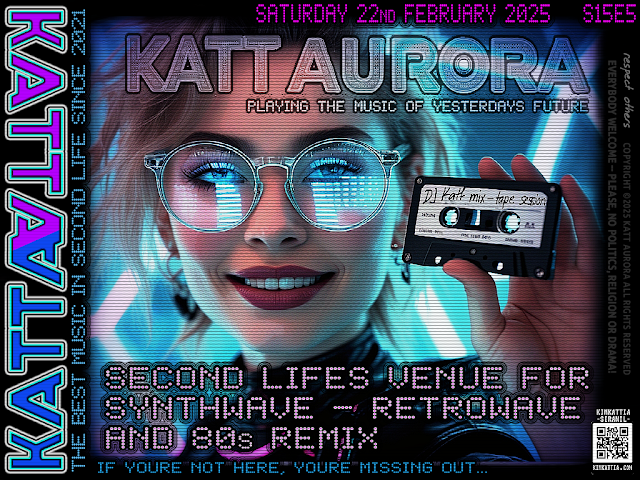Join us again this Saturday at 6pm Second Life Time at the Kimkattia Dome, for another DJ Katt Mixtape Session featuring a the music of yesterday's future - the best in Synthwave, Retrowave and 80s remixes.
The Music of Yesterday’s Future: The Aesthetic and Cultural Significance of Synthwave and Retrowave
Introduction
Music has always served as a portal to different eras, both real and imagined. Among the many genres that have embraced nostalgia as a core element, few do so as vividly as synthwave and retrowave. These music genres are not merely artistic expressions but also cultural movements that encapsulate the vision of the future as it was imagined in the past. The concept of "The Music of Yesterday’s Future" speaks to how synthwave and retrowave use the sonic and visual aesthetics of the 1980s to create an evocative and immersive experience that blends nostalgia with futurism. This essay explores the origins, stylistic elements, cultural significance, and ongoing evolution of these genres.
The Origins of Synthwave and Retrowave
Synthwave and retrowave emerged in the early 2000s as an homage to the music, aesthetics, and futuristic visions of the 1980s. Artists such as Kavinsky, College, and Mitch Murder helped define the genre, drawing inspiration from the electronic scores of film composers like John Carpenter, Vangelis, and Tangerine Dream. The resurgence of 1980s culture in films, video games, and television further fueled the popularity of these genres. Movies such as Drive (2011) and TV shows like Stranger Things (2016) played a crucial role in introducing synthwave to a broader audience.
The term “retrowave” is often used interchangeably with synthwave, though some distinctions exist. While synthwave emphasizes the synthesized sounds and futuristic elements of 1980s culture, retrowave encompasses a broader spectrum, including Italo-disco, outrun, and vaporwave influences. Together, these styles represent a reimagining of an era where analog dreams met digital aspirations.
Stylistic and Aesthetic Elements
Synthwave and retrowave are defined by their distinct soundscapes and visual aesthetics, both of which are deeply rooted in 1980s futurism. Sonically, these genres rely on:
- Analog synthesizers and drum machines: Classic synthesizers such as the Roland Juno-106 and Yamaha DX7 provide the warm, analog tones characteristic of synthwave music.
- Driving basslines and arpeggiated melodies: Many tracks feature pulsating, repetitive basslines and sweeping melodies that create a sense of movement and cinematic grandeur.
- Reverberated snares and gated drums: These elements replicate the production techniques of 1980s pop and film scores, enhancing the genre’s nostalgic feel.
- Atmospheric textures and cybernetic themes: Many compositions incorporate ambient sounds, VHS-style distortions, and futuristic motifs to reinforce the aesthetic of a neon-lit cyberpunk cityscape.
Visually, the genre is marked by neon colors, grid-lined landscapes, retro-futuristic typography, and imagery inspired by 1980s science fiction and action films. Cover art, music videos, and promotional materials frequently evoke themes of high-speed car chases, neon-lit skylines, and digital dystopias.
The Cultural Significance of Yesterday’s Future
Synthwave and retrowave are more than nostalgic tributes; they represent a longing for a particular vision of the future—one that was imagined during the 1980s but never fully materialized. This imagined future, with its flying cars, cybernetic enhancements, and neon cityscapes, stands in stark contrast to the actual digital age, where sleek minimalism and corporate technology dominate.
This dissonance between past expectations and present realities fuels the appeal of synthwave. In an era marked by rapid technological change and an uncertain future, these genres offer a comforting escape into a world where the future felt tangible, thrilling, and full of possibilities. For many listeners, synthwave serves as both a form of escapism and a critique of modernity, highlighting the contrast between the optimism of past decades and contemporary anxieties about technology and society.
The Evolution and Future of Synthwave and Retrowave
While synthwave remains deeply rooted in nostalgia, it is not a static genre. Contemporary artists continue to experiment, blending synthwave elements with other genres such as metal, lo-fi, and industrial music. Subgenres such as darksynth, which incorporates heavier, more aggressive tones, and chillwave, which emphasizes ambient and relaxed soundscapes, have emerged as offshoots of the original movement.
Furthermore, the global nature of digital music distribution has allowed synthwave to thrive as an online phenomenon. Platforms like Bandcamp, YouTube, and streaming services have given independent artists unprecedented access to audiences worldwide. Live performances, once rare in the synthwave community, are becoming more common, with festivals and themed events dedicated to the genre.
As technology continues to evolve, the relationship between synthwave and its vision of the future will also shift. Whether the genre remains a nostalgic tribute or evolves into something that embraces new futuristic possibilities, it will continue to serve as a unique reflection of humanity’s ever-changing perception of the future.
Conclusion
Synthwave and retrowave encapsulate “The Music of Yesterday’s Future” by preserving and reinterpreting the aesthetics of a bygone era’s vision of tomorrow. Through their distinctive soundscapes and visuals, these genres provide a bridge between the past’s imagined future and the present’s complex reality. Whether serving as a form of escapism, artistic expression, or cultural commentary, synthwave and retrowave remind us of the optimism, excitement, and creativity that defined past visions of the future. In doing so, they not only pay homage to a lost era but also offer a way to reimagine and reconnect with the dreams of yesterday.Join us again this Saturday at 6pm Second Life Time at the Kimkattia Dome, for another DJ Katt Mixtape Session featuring a the music of yesterday's future - the best in Synthwave, Retrowave and 80s remixes.
